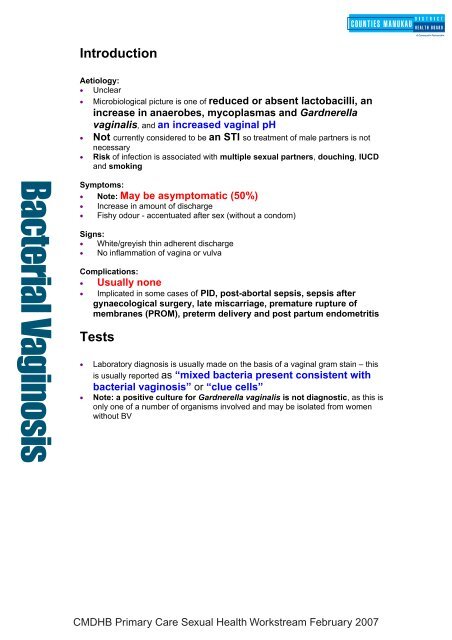Bacterial Vaginosis
Bacterial Vaginosis
Bacterial Vaginosis
You also want an ePaper? Increase the reach of your titles
YUMPU automatically turns print PDFs into web optimized ePapers that Google loves.
Introduction<br />
Aetiology:<br />
• Unclear<br />
• Microbiological picture is one of reduced or absent lactobacilli, an<br />
increase in anaerobes, mycoplasmas and Gardnerella<br />
vaginalis, and an increased vaginal pH<br />
• Not currently considered to be an STI so treatment of male partners is not<br />
necessary<br />
• Risk of infection is associated with multiple sexual partners, douching, IUCD<br />
and smoking<br />
<strong>Bacterial</strong> <strong>Vaginosis</strong><br />
Symptoms:<br />
• Note: May be asymptomatic (50%)<br />
• Increase in amount of discharge<br />
• Fishy odour - accentuated after sex (without a condom)<br />
Signs:<br />
• White/greyish thin adherent discharge<br />
• No inflammation of vagina or vulva<br />
Complications:<br />
• Usually none<br />
• Implicated in some cases of PID, post-abortal sepsis, sepsis after<br />
gynaecological surgery, late miscarriage, premature rupture of<br />
membranes (PROM), preterm delivery and post partum endometritis<br />
Tests<br />
• Laboratory diagnosis is usually made on the basis of a vaginal gram stain – this<br />
is usually reported as “mixed bacteria present consistent with<br />
bacterial vaginosis” or “clue cells”<br />
• Note: a positive culture for Gardnerella vaginalis is not diagnostic, as this is<br />
only one of a number of organisms involved and may be isolated from women<br />
without BV<br />
CMDHB Primary Care Sexual Health Workstream February 2007
Specimen Collection<br />
• High vaginal Transwab – lab will perform gram stain<br />
Management<br />
General Advice:<br />
• Avoid douching<br />
Do treat:<br />
<strong>Bacterial</strong> <strong>Vaginosis</strong><br />
1. Symptomatic women with a vaginal gram stained slide reported as BV<br />
2. Asymptomatic high-risk pregnant women (previous preterm<br />
delivery) - the results of clinical trials have been conflicting.<br />
However, the available evidence suggests that treatment of these women may<br />
improve pregnancy outcome.<br />
3. Asymptomatic women pre-TOP or pre-IUCD insertion: Current<br />
acceptable practice is that asymptomatic women pre-TOP or pre-<br />
IUCD insertion should be treated to reduce the chances of postprocedure<br />
Pelvic Inflammatory Disease.<br />
The evidence to support this is limited however, and is still under review.<br />
Don’t treat:<br />
• Asymptomatic women who do not fit the above criteria<br />
Notes:<br />
• Asymptomatic low risk pregnant women: There is not enough<br />
evidence to support routine treatment in order to prevent pre-term delivery and<br />
peri-partum sepsis. There is no evidence for routine screening for BV in<br />
pregnancy.<br />
Management<br />
Nitroimidazoles:<br />
Metronidazole 400mg bd po 7 days<br />
Note: Other nitroimidazoles in a 7 day course are probably effective for the treatment<br />
of BV but are not included in the recommended regimens due to lack of evidence.<br />
Alternative treatment:<br />
1. Metronidazole 2G po stat (only 60% effective)<br />
2. Clindamycin 300mg bd for 7 days (note specialist recommendation required)<br />
Note: Intravaginal clindamycin and metronidazole are not available at present in NZ.<br />
CMDHB Primary Care Sexual Health Workstream February 2007
Pregnancy and breastfeeding:<br />
1. Metronidazole 400mg bd po for 7 days<br />
• The 7 day course is preferred to avoid high peak serum levels, and to ensure<br />
eradication of organisms from the chorioamnion when treating women at high<br />
risk for pre-term birth<br />
• Metronidazole can affect taste of breast milk<br />
• Metronidazole is now licensed for use at any gestation<br />
• Repeat high vaginal swab 1 month after treatment if patient pregnant and<br />
high risk<br />
2. Clindamycin 300mg bd for 7 days (note specialist recommendation required)<br />
<strong>Bacterial</strong> <strong>Vaginosis</strong><br />
Recurrent bacterial vaginosis<br />
1. Relapse rate may be reduced if condoms are used for 1 month after treatment<br />
2. Longer courses of metronidazole for 10 – 14 days<br />
3. Regular monthly stat doses of metronidazole at the time of menstruation<br />
Referral Guidelines<br />
Referral to a Specialist Sexual Health Service is recommended for:<br />
• Recurrent bacterial vaginosis<br />
CMDHB Primary Care Sexual Health Workstream February 2007

















